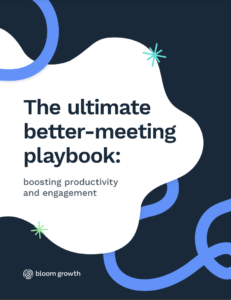We earn from qualifying purchases from Amazon Associate links.
This blog is written by Tricia Turk, Head of Client Experience at Bloom Growth. Read her full bio below.
You’ve probably heard that time is the one immaterial asset you can’t purchase or get more of. And nothing eats up more time, good or bad, than process. Inefficient processes drain energy, kill momentum, and frustrate teams. Efficient processes, on the other hand, free up time for creative work, build confidence, and increase output. That’s why thriving businesses invest in optimizing and refining their workflows.
In this blog, we’ll cover cost-effective, actionable ways to start optimizing business processes today.
How processes impact your culture
When everyone has a clear understanding of what to do next—and how to do it—they spend less time second-guessing, and more time contributing meaningfully. Good processes don’t just save time; they shape a healthy, engaged culture where people feel empowered to focus on what really matters.
One small business owner I worked with had a graphic designer and content writer constantly bumping heads over missed deadlines. Once they implemented a clear content handoff process through ClickUp and Slack, collaboration improved overnight—and so did team morale. Sometimes it’s not the people, it’s the process.
Exercise strategic quitting
When you’re trying to improve, it’s tempting to add new systems, but real optimization often starts with strategic quitting.
Ask yourself:
- Are there processes that take significant time but serve only a small subset of clients?
- Are you maintaining reports, meetings, or tasks “just because we always have”?
If yes, it might be time to sunset, update, outsource, or automate them.
🧠 Bloom tip: Pick one recurring task this week and ask: “What would happen if we stopped doing this?” If the answer is “not much,” it’s time to reevaluate.
Identify areas of opportunity
Focus on where pain is loudest—or where potential is quietly waiting.
- What slows your team down?
- Where are clients always getting stuck?
- What would make your life easier right now?
Gather insights from both inside and outside your business. Use tools like Google Forms to gather feedback anonymously from your team or clients. You may be surprised where the gold is hiding.
Use an Impact/Effort Matrix to prioritize
Next, consider what processes may have the most impact if optimized. Once you have a list of opportunities, map them out using an Impact/Effort Matrix. It’s a simple tool with four quadrants:
- High Impact / Low Effort → Do these first
- High Impact / High Effort
- Low Impact / Low Effort
- Low Impact / High Effort → Avoid these
This helps you avoid falling into the trap of “urgent but low-value” work and stay focused on quick, meaningful wins.

Explore AI solutions
AI isn’t just for tech giants anymore. Free and low-cost tools like ChatGPT and other models built into Canva and ClickUp can review process documentation, brainstorm workflow improvements, or even draft client communications.
A friend of mine in HR used ChatGPT to clean up their onboarding checklist, saving her team hours and improving the new hire experience.
AI best practices
- Be clear and specific in your prompts.
- Avoid inputting sensitive or confidential information.
- Test small, refine, and build.
🧠 Bloom tip: Start by asking: “What steps in this process feel tedious or repetitive?” Then test how AI could assist without replacing the human touch.
Automate repetitive and manual processes
When you’ve discovered a repetitive or manual task, ask: What do we keep doing that could be templated, delegated, or automated?
Relying on people to do repetitive tasks is not only error-prone but inefficient. Although some of these solutions come at a cost, they usually pay for themselves in streamlining the transfer of data and accuracy:
- Use Zapier or IFTTT to connect tools and eliminate manual data entry
- Use VLOOKUP or FILTER in Google Sheets to simplify reporting
- Build trigger-based emails for client milestones
Create email templates for FAQs in your CRM
Building better processes is great, but sometimes it takes investigative work to really hone in on their value.
For example, we discovered a common question coming in from clients and created a template for the support teams in our CRM. Sounds like a better process, right?
Here’s where we truly optimized the process—instead of stopping there, we dug a little deeper and asked, “Where in the client journey is this question not being answered?” (Which prompted the inquiry.)
We found that answering that question earlier in the journey reduced the number of times that the question was asked.
🧠 Bloom tip: Repetition is a red flag for needing automation. If you’ve done it three times, it might be time to automate it.
Eliminate redundant tasks and communications
Recurring tasks
Are there recurring tasks that can be automated in a CRM or other software? For example, if you’re always sending the same communication to coaching clients who complete or miss certain milestones, or if you want to ensure you connect with clients on a certain cadence, automate it!
Creating email templates and leveraging a CRM can save you time with built-in automation and personalization capabilities to allow for event-triggered communications.
Training
For an HR department and any manager, onboarding can be a very repetitive process. If there are components to your business, client, or employee onboarding that you find yourself or other team members going on endless loops, here are ways you can support different learning styles while improving your process:
- Create quick Loom videos or ScreenPal walkthroughs.
- Write up step-by-step guides for your knowledge base.
- Offer one-on-one coaching only where necessary.
Personally, I’ve found there is usually a mix of people who like the one-on-one approach of a training call and others who are DIYers. Supporting multiple paths to success will help create efficiency and help meet individuals where they’re at.
Internal communication
An elementary concept that has monumental weight is internal communication. Though simple, without a communicated process, your team may be trying to communicate in a variety of ways, which only leads to frustration. Instead, provide them with internal communication protocols like this:
- Use one platform for critical updates (Slack, Teams, etc.)
- Limit cross-platform noise (email + chat + text = chaos)
- Create “rules of engagement” so your team knows where to look first
For example, one-way or data-sensitive communications may be sent out by the leadership team via email, while day-to-day conversations may be held in Slack. Whatever your company decides, communicate the process!
🧠 Bloom tip: Consider enlisting the help of a growth framework like the Bloom Growth OS™. Business operating systems like this are built on the foundation of communication, which is essential for scalability and long-term growth.
Reduce unnecessary meetings
Meetings can be some of the most expensive things you do, and I still haven’t met anyone who loves being in a ton of meetings. If you find yourself holding meetings just to share information that could have been a message, there are better uses for that time.
Easy info-sharing swaps instead of meetings
- Use , Loom, BombBomb or Vidyard to deliver updates
- Share screen recordings of walkthroughs
- Replace status meetings with project boards (ClickUp, Asana, Notion)
If these options fail, then you can allocate your time in the meeting focused on any obstacles or opportunities then the actionable next steps.
Bonus: Ultimate better-meeting playbook
 If your meetings are necessary, make sure that you’ve got them structured optimally with the right people in attendance. This guide includes 10 years worth of experience and recommendations for the perfect meeting.
If your meetings are necessary, make sure that you’ve got them structured optimally with the right people in attendance. This guide includes 10 years worth of experience and recommendations for the perfect meeting.
Measure impact and celebrate wins
After you start implementing changes, ask those affected for feedback.
Did it save time?
Was it less error-prone?
Did it improve the client experience?
With so much working against us, it’s important to identify and celebrate the wins along the way, both big and small.
Remember to thank those who helped you in creating more efficient processes, and encourage a culture of continuous improvement to keep making experiences better for employees and clients.
Closing thoughts
Process optimization doesn’t have to be overwhelming or expensive. With a little intention and a lot of listening, you can transform time-sucking routines into streamlined systems that support your goals, your team, and your clients.
Keep it simple. Start small. Celebrate often.

Tricia Turk
Head of Client Experience
Tricia began her career at a boutique print and digital advertising agency, where she discovered her passion for creating amazing client experiences. From there, she has spent nearly 15 years leading, scaling and optimizing Customer Success teams in the fast-paced software industry across several verticals (advertising, marketing, automotive, and real estate). She is dedicated to being the voice of the customer within her organization while also fostering the growth of her team members.
Based in Minnesota, she shares her home with her husband and beloved dog, Ole. Outside of work, Tricia enjoys a range of outdoor activities—cross-country skiing, boating, waterskiing, hiking, and camping, as well as cooking, reading, and cherishing time with friends and family.

